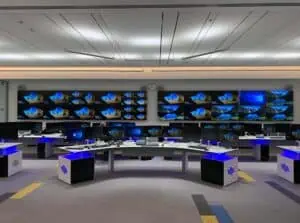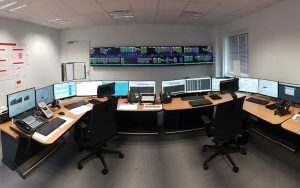In the eMove360° interview, Dr. Enno Littmann, CEO of IHSE GmbH, explains the increasing importance of control centers for the various forms of traffic management and what KVM technology in traffic control centers is all about.
KVM stands for “Keyboard, Video, Mouse”. KVM technology makes it possible to operate computers or servers over a long distance and, with the addition of a KVM switch, it allows users to easily select between computers from a central console in real time. It also enables centralized monitoring; several data feeds can be displayed on a video wall together and made available to several viewers at once. KVM creates a flexible working environment in which users can switch seamlessly between different computers and applications and use them simultaneously without being aware of the spatial separation in the work process. KVM technology is at its best when users are unaware of it, because it is intended to simplify work processes and not be the focus of attention itself.
Where is KVM technology used in the field of traffic management. To what extent does KVM help in the control of road traffic and other transport systems?

Highway operators also use our KVM to monitor and control traffic flows in real time to ensure efficient and safe traffic flow by activating lighting systems or speed limit displays from a central control center. An example of this is in the control rooms for the Mont Blanc tunnel.
KVM technology has long been used in transportation systems beyond road traffic. In the monitoring and control of rail traffic operations, in airport management and global air traffic control systems. Our KVM systems are used at many large airports around the world, including Frankfurt Airport, Orly Airport in Paris and several American airports. It is a crucial element in the control room for Sydney Trains’ urban rail traffic, Israel Railways and for high-speed lines of the French railway network.
Autonomous driving is the big topic in the future of road transport. What function does KVM fulfill in this field?

The primary role for KVM is within the control center. All information converges and is switched via a KVM system. Autonomous and semi-autonomous traffic of the future is only possible with the help of central control centers that collect and validate traffic data – for example via sensors on the vehicles or from external sources such as weather services – and derive recommendations for action or take measures, such as rerouting traffic or informing emergency services.
Control centers serve as central control points to coordinate the efficient flow of autonomous vehicles. Interaction with vehicle systems plays a critical role in autonomous and connected vehicles. Not only does this enable traffic to flow smoothly and as safely as possible it also reduces congestion, noise and harmful toxic emissions.
Over the past three years, you have been involved in the ALFRIED research project funded by the German Federal Ministry of Transport, that develops new concepts for automated and connected driving. What were the objectives?

The task is to develop a smart city control center to evaluate the requirements of future control rooms. The smart city control center is designed as an open demonstration that simulates real traffic operations.
The KVM system routes all incoming data and makes it available to operators who manage the traffic flow. Together with our cooperation partners from research and industry, we are able to develop and test various concepts under real conditions and present them to the public.
Where do you see the major challenges in the transportation networks of the future?
Control centers will be at the heart of future transport networks to an even greater extent than today. Traffic control centers are part of the critical infrastructure and as such must be reliable, able to manage data without corruption or inherent delay and above all, be protected against cyber-attacks.
Security failures can lead to considerable traffic disruption, accidents, restrictions in emergency services and more. The traffic control centers of the future must therefore meet security requirements that are insufficiently considered in current commercial control center concepts.
We have developed a security concept for the Smart City control center that uses the KVM system to eliminate the dangers posed by internal and external security threats on many levels. IT systems must incorporate the highest level of data and access security. Weak points must be identified and secured by cyber-resilient IT systems.
With improved defense mechanisms in all areas of new mobility, I am very confident about the new forms of autonomous transport systems and am convinced that we, as a society, will benefit enormously from its potential.
The interview appeared in eMove 360° Magazin, issue 2024-1.

